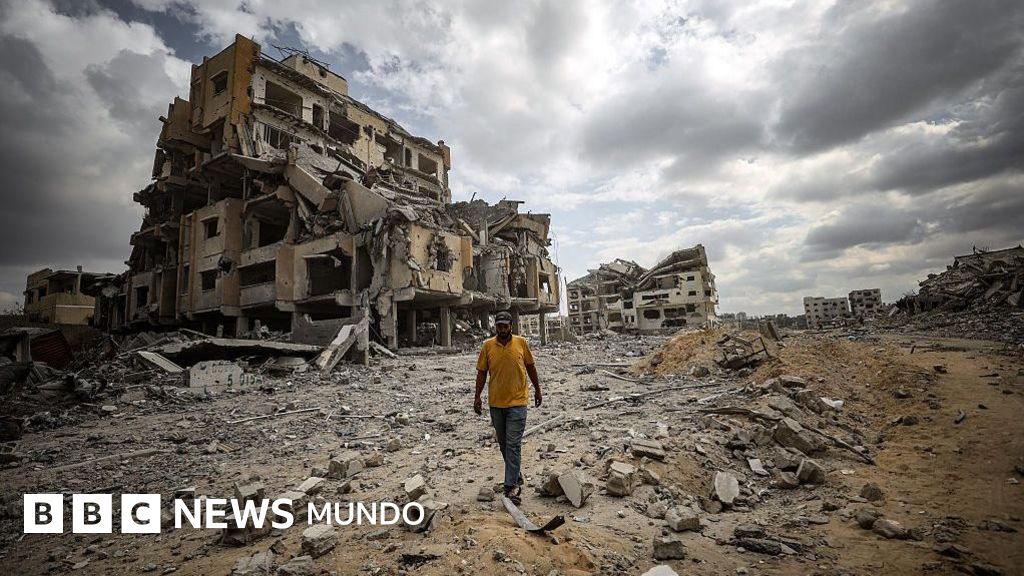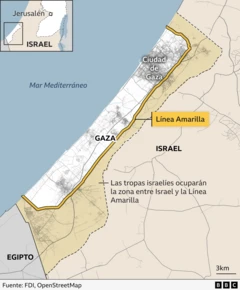
image source, Getty Images
-
- author, Benedict Garman and Barbara Metzler
- author title, BBC verification
Israel has destroyed more than 1,500 buildings remaining under its control in the Gaza Strip since the ceasefire agreement with Hamas began on October 10, according to satellite images reviewed by investigators. BBC verification.
New photos (the last one taken on November 8) show how entire areas controlled by the Israel Defense Forces (IDF) have been destroyed in less than a month by apparent demolition.
The actual number of buildings destroyed may be higher, as some areas could not be recorded by satellite.
Experts say the sabotage could violate several points in the ceasefire agreement backed by the United States, Egypt, Qatar and Turkiye.
An IDF spokesperson told the BBC that these procedures meet all conditions that are part of the ceasefire.
The 20 points laid out by US President Donald Trump, which form the basis for the ceasefire, state that “all military operations, including the use of airstrikes and artillery, will cease.”
President Trump himself has since said, “This war is over.”
However, through analysis of satellite images, the BBC was able to find that the IDF continued to destroy buildings on a large scale.
Change detection algorithms were used to analyze radar images taken before and after the start of the ceasefire, highlighting differences.
This gave us an idea of the extent of the destruction, and we then manually counted the buildings that were visibly destroyed.
We investigate destroyed buildings behind the Yellow Line, the border between Gaza’s north, south and east.
Under the cease-fire agreement, Israel agreed to withdraw its troops to the limit marked by a yellow line on a map published by the Israel Defense Forces.
Houses, orchards, and gardens were destroyed.
Many of the affected buildings, for example in eastern Khan Yunis around Abasan al-Kabila, appeared to be undamaged before being demolished.
Although it is difficult to tell from satellite images, these buildings had no obvious structural damage, and there were no obvious signs of nearby debris or changes in shape. They were houses with gardens, trees, and small orchards.

image source, Getty Images
Comparing this aerial satellite image taken at the start of the war in October 2023 with images taken before and after the start of the ceasefire reveals little change to many buildings.
Rana Khalil lived in Abbasan al-Kabila before taking shelter near al-Mawashi. She describes her home as a kind of “paradise” filled with “farms and vegetables.”
Today, the area, like much of Gaza, has been reduced to rubble.
“The Israeli army left us with nothing. They destroyed everything,” Rana says.
He added that former residents could hear the noise of destruction coming from “the tents we are in Al Mawashi.”
“Our hearts are broken,” he laments.
Satellite images show a similar situation in another area near al-Bayuk, east of the city of Rafah.
Many buildings that appeared undamaged before the ceasefire are now destroyed.
Aerial photos of the explosion released in early November showed plumes of dust rising from nearby ruins.
Destruction continues in Gaza City’s Shejaya district and near an Indonesian hospital on the edge of Jabalia refugee camp.
Eitan Shamir, former head of the Israeli Ministry of Strategy’s Directorate of National Security Principles, pointed out that the IDF’s actions do not apply to areas of the Gaza Strip inside the Yellow Line, suggesting they do not violate anything agreed to in the ceasefire.
Verified videos show controlled demolition and bulldozers destroying buildings after the ceasefire was signed. These buildings are geographically located and located inside the Yellow Line.

The bombing is a ‘ceasefire violation’
The Israel Defense Forces has defended its actions, with a spokesperson saying: “According to the terms of the ceasefire, all terrorist infrastructure, including tunnels, must be removed in Gaza. Israel will act in response to threats, violations and terrorist infrastructure.”
On October 18 last year, Israeli Defense Minister Israel Katz wrote on the X account that “the demilitarization of Gaza by destroying terrorist tunnels and terrorist infrastructure was clearly Israeli security policy.”
Article 13 of the Trump peace plan released by the White House (the closest thing to an official publication of what was agreed to in the ceasefire) states that “all offensive military or terrorist infrastructure, including tunnels and weapons production, shall be destroyed and shall not be rebuilt.”
They also suggested that the Gaza demilitarization process would be carried out “under the supervision of independent monitors.”
“This is definitely a violation of the ceasefire,” HA Hellyer, a Middle East political expert at the United Services Institute, told the BBC. think tank British.
“However, Washington does not want the ceasefire to be recognized as such and insists that it must remain in place even if it has not materialized.”
But Shamir denies that the IDF is violating the ceasefire.
An IDF source told the BBC that his view was that “Hamas is allowed to do what it wants in the areas it controls, and Israel is allowed to do what it wants in the areas it controls.”
Sources said the IDF believes Hamas is unlikely to comply with the second phase of the agreement.
“Therefore, we need to prepare the area for continued fighting so that they do not have the option of ambushing our soldiers.”
He also claims that Hamas frequently attempts to infiltrate beyond the Yellow Line and that there is still a long tunnel to go before it can be neutralized.

image source, Getty Images
Some analysts, including Adil Haq, a law professor at Rutgers University in the United States, have suggested that Israel may be violating the laws of war, which prohibit the destruction of civilian property by an occupying power.
Mr. Haq pointed out that an exception to this rule could only arise from “military operations, that is, combat or direct preparation for combat,” and argued that “it cannot be considered that military operations absolutely required the destruction of such significant civilian property” during the ceasefire.
Hugh Lovatt, a senior fellow at the European Council on Foreign Relations, said the vandalism could ultimately jeopardize peace plans.
“The longer Israel remains in the area inside the Yellow Line, the worse the problem of destruction will be,” he points out.
“Ultimately, the perception that Israel is trying to delay its withdrawal and establish a new fait accompli there, as it is already doing in the West Bank, will increase the threat to maintaining the ceasefire,” he concluded.

Subscribe here Sign up for our new newsletter and we’ll bring you the week’s best content every Friday.
Don’t forget that you can also receive notifications in the app. Please download and activate the latest version.



